Homeowners embarking on a new design or renovation project often focus on achieving a specific look, influenced by social media and design magazines. However, a significant number of these individuals later report a single, recurring regret: prioritizing style over practicality. This common home design regret has emerged as a major concern for professional designers who are frequently tasked with correcting these functional oversights.

The Pursuit of Trend-Driven Aesthetics
The rise of digital platforms like Instagram and Pinterest has democratized interior design, giving homeowners unprecedented access to a vast array of trends. This has, in turn, fueled a desire for aspirational, “magazine-ready” spaces. According to a survey by Havenly, an online interior design service, a majority of clients express a desire for homes that reflect current trends, often citing specific looks like “minimalist,” “farmhouse chic,” or “industrial.”
However, industry experts report a frequent disconnect between these visual aspirations and the realities of daily living. “I’ve seen so many clients prioritize a look that they saw on social media, only to realize later that it doesn’t align with how they actually live,” said Paulina Hospod, an interior designer at AhA!nteriors, in an interview. “They install black matte faucets because they are trendy, then find out they show every single water spot. Or they choose a beautiful, porous marble countertop without considering that it will stain with a single splash of lemon juice.”
This pursuit of fleeting trends often leads to significant dissatisfaction. An analysis by the design platform By Design and Viz found that approximately 60% of homeowners surveyed were unhappy with trendy choices once those styles fell out of popularity.
The Consequences of Impractical Design Choices
This focus on aesthetic over function manifests in several specific areas of the home, creating daily frustrations for residents. Kitchens, as high-traffic and high-utility spaces, are a frequent source of these issues. Open shelving, while visually appealing and popular in minimalist design, often becomes cluttered and dusty, undermining the clean look it was intended to create. Similarly, deep, low cabinets without pull-out shelving, a common design mistake, can make retrieving cookware difficult and inconvenient.
Beyond the kitchen, lighting is another critical element where form often wins out over function, with detrimental results. Many homeowners rely solely on a single overhead fixture, a design choice that can make a room feel dim and unwelcoming. Interior designer Regan Billingsley, quoted in Real Simple, emphasized the importance of layered lighting. “Poor lighting can leave rooms feeling lifeless, dull, or unbalanced,” she noted. “Layering different light sources—ambient, task, and accent lighting—is essential for creating a flexible and inviting atmosphere.”
The Call for Functional and Timeless Design
For designers, the solution lies in a more holistic and deliberate approach to home design. Experts recommend that homeowners live in a space for a period before undertaking major renovations. This allows them to understand the flow of the house and identify their actual needs, a principle advocated by architect Victoria Brown, co-founder of Musson Brown Architects. She notes that this process can reveal issues like a lack of dedicated storage in open-plan spaces or the need for a quiet zone for remote work.
Choosing durable, classic materials over trendy, high-maintenance alternatives is another key recommendation. While polished concrete floors or glossy tiles may look sleek, they can be impractical for homes with children or pets. Designers now frequently steer clients toward materials that age gracefully, such as engineered wood or quartzite, which offer the look of natural stone with superior durability.
The central message from the design community is clear: a home should be a functional, comfortable sanctuary, not a static showpiece. The most enduring designs are those that serve the inhabitants first. By prioritizing their lifestyle and daily routines over fleeting trends, homeowners can avoid the costly and frustrating cycle of design regret.
